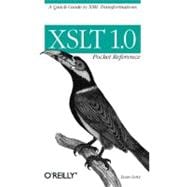
Evan Lenz is an XML developer specializing in XSLT. He recently worked for Infopop Corporation as an interface engineer, and has served on the W3C XSL Working Group, spoken at various XML conferences, and co-authored O'Reilly's Office 2003 XML. Evan holds a Bachelor of Music degree from Wheaton College (IL), with majors in Piano Performance and Philosophy. He currently lives in Seattle, Washington.
| Data Model | p. 1 |
| Node Types | p. 1 |
| Node Properties | p. 2 |
| The XPath Language | p. 6 |
| Data Types | p. 6 |
| Expression Context | p. 7 |
| Kinds of Expressions | p. 8 |
| Node-Set Expressions | p. 9 |
| Number Expressions | p. 19 |
| String Expressions | p. 19 |
| Boolean Expressions | p. 20 |
| How XSLT Works | p. 23 |
| Stylesheet Structure | p. 23 |
| Processing Model | p. 24 |
| Template Rule Content | p. 35 |
| Whitespace Stripping | p. 39 |
| Serializing the Result Tree | p. 40 |
| XSLT Elements by Use Case | p. 41 |
| Elements | p. 42 |
| Top-Level Elements | p. 42 |
| Instructions | p. 43 |
| Special Elements | p. 44 |
| QNames | p. 45 |
| Element Reference | p. 45 |
| Functions | p. 89 |
| XPath Functions | p. 89 |
| XSLT Functions | p. 90 |
| Data Type Conversions | p. 90 |
| Function Reference | p. 94 |
| Extending XSLT | p. 108 |
| Extension Functions | p. 108 |
| Extension Elements | p. 109 |
| EXSLT | p. 110 |
| EXSLT-Common | p. 113 |
| EXSLT-Dates and Times | p. 116 |
| EXSLT-Functions | p. 129 |
| EXSLT-Math | p. 133 |
| EXSLT-Random | p. 136 |
| EXSLT-Sets | p. 138 |
| EXSLT-Dynamic | p. 140 |
| EXSLT-Regular Expressions | p. 148 |
| EXSLT-Strings | p. 152 |
| XPath 1.0 Grammar | p. 159 |
| XSLT Pattern Grammar | p. 164 |
| Index | p. 165 |
| Table of Contents provided by Ingram. All Rights Reserved. |
The New copy of this book will include any supplemental materials advertised. Please check the title of the book to determine if it should include any access cards, study guides, lab manuals, CDs, etc.
The Used, Rental and eBook copies of this book are not guaranteed to include any supplemental materials. Typically, only the book itself is included. This is true even if the title states it includes any access cards, study guides, lab manuals, CDs, etc.